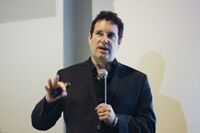“霍德・利普森 Hod Lipson”的版本间的差异
(→相关链接) |
|||
| 第1行: | 第1行: | ||
| − | + | {{#seo: | |
| + | |keywords=人工生命,美国机器人工程师 | ||
| + | |description=霍德·利普森 | ||
| + | }} | ||
| + | <div style="width:100%;height:300px;align:center"> | ||
| + | <div style="width:40%;float:left;padding-top:10px"> | ||
| + | [[File:Waiter-_The_New_World_of_3D_Printing_and_Computation_(9972110315).jpg|200px]] | ||
| + | </div> | ||
| + | <div style="width:58%;float:left;margin-left:2%;padding-top:30px"> | ||
| + | {| class="wikitable" | ||
| + | |- | ||
| + | ! 类别 !! 信息 | ||
| + | |- | ||
| + | | 姓名|| 霍德・利普森 Hod Lipson | ||
| + | |- | ||
| + | | 出生日期 || 1967年 | ||
| + | |- | ||
| + | | 出生地 || 海法, 以色列 | ||
| + | |- | ||
| + | | 公民身份: || 美国 | ||
| + | |- | ||
| + | | 母校: || 以色列理工大学 | ||
| + | |- | ||
| + | | 工作场所: || 麻省理工大学, 布兰迪斯大学, 康奈尔大学, 哥伦比亚大学 | ||
| + | |- | ||
| + | | 领域: || 机器人技术,机械工程 | ||
| + | |- | ||
| + | | 成就: || [[Fab@Home多元材料3D打印机]], [[自我意识的机器人]], [[自我复制的机器人]] | ||
| − | + | |} | |
| − | + | ||
| − | + | </div> | |
| − | + | </div> | |
| − | |||
| − | |||
| − | |||
| − | |||
| − | |||
| − | |||
| − | |||
| − | |||
| − | |||
| − | |||
| − | |||
| − | |||
| − | |||
| − | |||
| − | |||
| − | |||
| − | |||
| − | |||
| − | |||
| − | |||
| − | |||
| − | |||
| − | |||
| − | |||
| − | |||
| − | |||
'''霍德・利普森 Hod Lipson''',1967年生于以色列的海法,<ref>{{cite web |title=Hod Lipson: Books, Biogs |website=Amazon.co.uk |url=https://www.amazon.co.uk/Hod-Lipson/e/B008VGBM8E |accessdate=2015-08-10 |quote=Hod Lipson (1967-) was born in Haifa, Israel}}</ref>是一名美国机器人工程师,哥伦比亚大学创意机器实验室的主任。利普森的研究工作主要关注进化机器人学、设计自动化、快速成型、人工生命以及创造可以展示人类某些方面创造力的机器。<ref name="cornellSun">{{cite web |url=http://cornellsun.com/node/33721 |title=The Scientist: Hod Lipson |last=OBrien |first=Sean |date=19 November 2008 |publisher=The Cornell Daily Sun |accessdate=2008-12-25 |archive-url=https://web.archive.org/web/20090108071638/http://cornellsun.com/node/33721 |archive-date=8 January 2009 |url-status=dead |df=dmy-all }}</ref><ref name="cornellBio">{{cite web |url=http://www.mae.cornell.edu/Lipson/ |title=Hod Lipson |publisher=Cornell Mechanical & Aerospace Engineering (MAE) |accessdate=2008-12-25}}</ref>他的出版物已经被引用了超过26000次, h-index 指数为73,000。<ref>{{Cite web|title = Hod Lipson – Google Scholar Citations|url = https://scholar.google.com/citations?user=F_Go4V4AAAAJ&hl=en|website = scholar.google.com|accessdate = 2019-10-07}}</ref>在2018年的人工智能纪录片《你信任这台电脑吗?》中,利普森接受了采访。 | '''霍德・利普森 Hod Lipson''',1967年生于以色列的海法,<ref>{{cite web |title=Hod Lipson: Books, Biogs |website=Amazon.co.uk |url=https://www.amazon.co.uk/Hod-Lipson/e/B008VGBM8E |accessdate=2015-08-10 |quote=Hod Lipson (1967-) was born in Haifa, Israel}}</ref>是一名美国机器人工程师,哥伦比亚大学创意机器实验室的主任。利普森的研究工作主要关注进化机器人学、设计自动化、快速成型、人工生命以及创造可以展示人类某些方面创造力的机器。<ref name="cornellSun">{{cite web |url=http://cornellsun.com/node/33721 |title=The Scientist: Hod Lipson |last=OBrien |first=Sean |date=19 November 2008 |publisher=The Cornell Daily Sun |accessdate=2008-12-25 |archive-url=https://web.archive.org/web/20090108071638/http://cornellsun.com/node/33721 |archive-date=8 January 2009 |url-status=dead |df=dmy-all }}</ref><ref name="cornellBio">{{cite web |url=http://www.mae.cornell.edu/Lipson/ |title=Hod Lipson |publisher=Cornell Mechanical & Aerospace Engineering (MAE) |accessdate=2008-12-25}}</ref>他的出版物已经被引用了超过26000次, h-index 指数为73,000。<ref>{{Cite web|title = Hod Lipson – Google Scholar Citations|url = https://scholar.google.com/citations?user=F_Go4V4AAAAJ&hl=en|website = scholar.google.com|accessdate = 2019-10-07}}</ref>在2018年的人工智能纪录片《你信任这台电脑吗?》中,利普森接受了采访。 | ||
2022年4月5日 (二) 11:30的版本
| 类别 | 信息 |
|---|---|
| 姓名 | 霍德・利普森 Hod Lipson |
| 出生日期 | 1967年 |
| 出生地 | 海法, 以色列 |
| 公民身份: | 美国 |
| 母校: | 以色列理工大学 |
| 工作场所: | 麻省理工大学, 布兰迪斯大学, 康奈尔大学, 哥伦比亚大学 |
| 领域: | 机器人技术,机械工程 |
| 成就: | Fab@Home多元材料3D打印机, 自我意识的机器人, 自我复制的机器人 |
霍德・利普森 Hod Lipson,1967年生于以色列的海法,[1]是一名美国机器人工程师,哥伦比亚大学创意机器实验室的主任。利普森的研究工作主要关注进化机器人学、设计自动化、快速成型、人工生命以及创造可以展示人类某些方面创造力的机器。[2][3]他的出版物已经被引用了超过26000次, h-index 指数为73,000。[4]在2018年的人工智能纪录片《你信任这台电脑吗?》中,利普森接受了采访。
传记
利普森在1989年和1998年分别获得了以色列理工学院机械工程系理学学士学位和博士学位。他曾在布兰迪斯大学计算机科学系担任助理教授,同时也是麻省理工学院机械工程系博士后研究员。[5]之后,利普森在康奈尔大学担任了14年教授并于2015年进入哥伦比亚大学任教。[3]
研究
利普森进行了机器学习相关研究,并在2007年的 TED 大会上展示了他的“有自我意识”的机器人。[6]
从2009年开始,他和他在康奈尔大学的研究生 Michael Schmidt 共同开发了一个名为 Eureqa [7] 的软件,该软件能够从数据集中推导出方程、数学关系和自然定律。例如,从双摆的位置和速度的数据集中推导出牛顿第二运动定律。[8][9]2011年,报道称Eureqa在一项更复杂的任务上取得了成功:重新推导了七个方程来描述缺氧酵母细胞中各种化合物的水平是如何变化的。[10]
在机器人自我意识的研究中,他提倡将“自我模拟”作为初步阶段。[11]
利普森参与的团队创造了许多机器,其中包括:
- Fab@Home fabbers ——低成本的“3d 打印机”。[12][13]
- 自我复制机器人——只要有合适的部件,就能够复制自己的简单结构。[14]
- ”有自我意识的机器人”——该机器可以对阻碍行为的损坏进行补偿。[15]
- 分子自我繁殖机器人。
参考文献
- ↑ "Hod Lipson: Books, Biogs". Amazon.co.uk. Retrieved 2015-08-10.
Hod Lipson (1967-) was born in Haifa, Israel
- ↑ OBrien, Sean (19 November 2008). "The Scientist: Hod Lipson". The Cornell Daily Sun. Archived from the original on 8 January 2009. Retrieved 25 December 2008.
- ↑ 3.0 3.1 "Hod Lipson". Cornell Mechanical & Aerospace Engineering (MAE). Retrieved 2008-12-25.
- ↑ "Hod Lipson – Google Scholar Citations". scholar.google.com. Retrieved 2019-10-07.
- ↑ "Hod Lipson: CV" (PDF). Cornell Mechanical & Aerospace Engineering (MAE). Retrieved 2015-08-10.
- ↑ TED2007. "Hod Lipson builds "self-aware" robots". Ted.com. Retrieved 2013-04-14.
- ↑ "Eureqa | Cornell Creative Machines Lab". Creativemachines.cornell.edu. Retrieved 2013-04-14.
- ↑ The New York Times "Hal, Call Your Office: Computers That Act Like Physicists " By Kenneth Chang Published: April 2, 2009
- ↑ Keim, Brandon (2009-12-03). "Download Your Own Robot Scientist | Wired Science". Wired.com. Retrieved 2013-04-14.
- ↑ "Software Scientist | Technology". Science News. Retrieved 2013-04-14.
- ↑ John Pavlus (2019-07-09). "Curious About Consciousness? Ask the Self-Aware Machines". Quanta Magazine. Retrieved 2019-10-21. https://en.wikipedia.org/wiki/Defekte_Weblinks?dwl={{{url}}} Seite nicht mehr abrufbar], Suche in Webarchiven: Kategorie:Wikipedia:Weblink offline (andere Namensräume)[http://timetravel.mementoweb.org/list/2010/Kategorie:Wikipedia:Vorlagenfehler/Vorlage:Toter Link/URL_fehlt
- ↑ Ward, Logan (November 2007). "Fab at Home, Open-Source 3D Printer, Lets Users Make Anything". Popular Mechanics. Archived from the original on 2008-12-23. Retrieved 2008-12-25.
- ↑ Binns, Corey (10 May 2007). "The Desktop Factory". popsci.com. Retrieved 2008-12-25.
- ↑ Steele, Bill (11 May 2005). "Simple but seminal: Cornell researchers build a robot that can reproduce". Cornell News Service. Retrieved 2008-12-25.
- ↑ Bongard, Josh; Victor Zykov; Hod Lipson (21 November 2006). "Robotic Introspection: Self Modeling". Cornell CCSL. Retrieved 2008-12-25.
相关链接
编辑推荐
人工生命入门路径
集智斑图作者JC整理了Lana Sinapayen为人工智能研究者们提供的一份人工生命入门指南。Lana Sinapayen是索尼计算机科学实验室和东京地球生命科学研究所的一名人工生命研究者,同时也是国际人工生命学会理事会成员。
NetLogo去实现
北京师范大学系统科学学院张江教授通过数个案例教会大家如何去动手搭建一个多主体仿真模型,教你如何用Netlogo程序编写人工生命。
冯·诺依曼的遗产:寻找人工生命的理论根源
人工生命是可以回答人工智能无法思考的问题的。尽管自从九十年代之后,人工生命才逐渐发展起来,成为独立于人工智能的科学领域,但它的理论根源却可以追溯到二十世纪五十年代。那个时候,一个伟大的数学家兼发明家冯·诺依曼正在思考如何制造可以复制自身的机器。这个自复制机器的核心目的并不在于生命自复制这个问题本身,而是希望寻找出一条途径,能够让机器一劳永逸地“抵抗熵增”,不断朝越来越复杂的方向进化,而这一方法极有可能就是制造强人工智能机器,甚至是具有自我意识的智能机器的正确途径。
本中文词条由孙小滢、我是猫翻译,薄荷编辑,如有问题,欢迎在讨论页面留言。
本词条内容源自wikipedia及公开资料,遵守 CC3.0协议。

